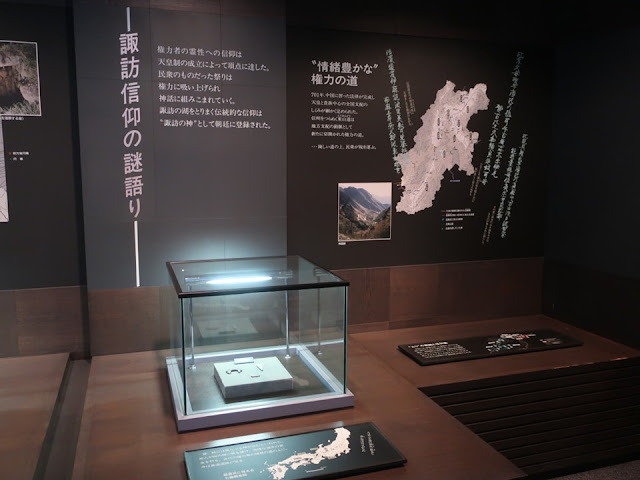The museum is in front of Suwa Taisya Kamisha, Honmiya (shrine, https://suwataisha.or.jp/en/) in central Japan. The deities have enshrined in Suwa since the ancient era. People have worshipped and have served for a long time. The rituals exhibited in the museum make us feel existence of the deities. The related events tell us the life of locals. Photos are uploaded under the permission of the museum office.
博物館は、諏訪大社上社の前にあります。諏訪は古代から神様が祀られた地。人々は、御柱祭などで信仰を続け、奉仕してきました。展示されている祭祀の様子から神様の存在が感じられ、その周りにある人々の暮らしが分かります。博物館に事前申請と許可を得て撮影・掲載しました。
The hot-spring gushes in Suwa; it is also longstanding hot-spring resort. There is a footbath in the museum site (lower right).
諏訪は有名な温泉地。博物館の敷地には足湯(右下)もありますよ。
Permanent exhibition roomⅠ(History)、常設展示室1(歴史)
The room has sufficient space and the light is dimmed. I felt like knowing the prayers of creators who made the earthenware in the Jomon period (from around 12,000 years ago to around 2,400 years ago).
Btw, you can receive “Goshuin” of three clay figures (lower right). Goshuin (red ink stamp) is originally issued to pilgrim by shrine or temple. Nowadays, it is issued by castles and so on; it’s a trend.
展示室内は照明を落としてあり、展示スペースも十分。縄文時代の部屋では土器類を作った人たちの気持ち(祈りの気持ち)がわかるような気がします。
ところで、土偶札所巡りというのがあって、こちらでは、三つの御朱印をいただけます。今風ですね(右下)。
After the rice farming started, kings emerged. It says, “As land changed to arable one, the conflict between civilization and nature was intensifying. The measure to defuse it was needed; it was a ritual. The ruler tried to defuse nature‘s fury on behalf of people. People became to obey the spiritual-power of the ruler not nature.” It is new for me, because I thought people had been obeyed nature until the modern era. The enlarged photo (upper right) shows a ritual at the top of the hill (Ittokizaka ancient burial mound). Excavated stem cups are also exhibited (lower right).
Reference: Edo period, Meiji period and outline of Japanese history
弥生時代を経て古墳時代に入ると、「開発が進み、人の文化と自然との対立が深まる。自然との和解ー祭りーが必要になる。権力者は人々を代表して自然と交わり荒ぶる自然の力をおさめようとする。人と自然の秩序を統合する王者。自然ではなく権力者の霊力への従属が始まる」と書かれています。私は、近代化までは、人々は抗いようがない自然に隷属していたと思っていたので、新鮮な記述でした。自然や神ではなく権力者の霊力に従属していた時期があったのですね。右上は諏訪湖が見える丘の先端で行われた一時坂古墳の祭祀復元模型(1/40)、右下は発掘された高坏のような土器です。
The power of Yamato Dynasty reached Suwa. The deities of Suwa were registered by the dynasty with 3132 deities (there are many in Japan). It is strange that a deity is on the list and another is not; human did it. I often visit a shrine; every deity should be respected equally. It means the dynasty became powerful more than deities, didn’t they?
大和朝廷の力が信州にもおよび、「諏訪の湖をとりまく伝統的な信仰は“諏訪の神”として朝廷に登録された」と書かれています。
たしかに、927年に発行された延喜式には、3132座の祭神、2861の神社が登録され、「式内の社」となりました。私は何かにつけて鎮守の神様にお参りに行きますが、その神様や神社がランク付けされたり、ランク外になったり(式外の社)なったりするのは変な感じです。手を合わせる時は、どこの神様も同じように敬っています。神様を超える権力を朝廷は持ったということですね。
Establishment of Suwa Shrine. Although the dynasty was getting to control Japan, an indigenous faith remains. The panel at lower left asks three questions.
諏訪神社の形成。天皇の支配が進む中、諏訪独特の信仰があります。左下のパネルでは、三つの疑問が投げかけられています。
The question in center attracted me a lot. It is written, “A boy becomes a living deity “Oohouri”. Is it rerated to the fact that Suwa Shrine doesn’t have a main hall?” It is very special that an actual human being is enshrined.
中央の絵では、「童男が生き神大祝(おおほうり)に化身する。生き神大祝の存在は、諏訪神社に本殿がないことと関係するのだろうか。」と疑問を投げかけられます。引き込まれる展示でした。
The part of the residence of “Oohouri” remains near the museum. His exclusive clothing and a model of his whole residence are exhibited.
博物館の近くにある大祝邸跡。今も江戸時代に作られた表門(写真)や一部の部屋が残っています。博物館には大祝の装束や邸宅の模型も展示されています。
The residence of his high-ranking retainer “Moriya” also remains near the museum. There is a museum which preserves Moriya’s documents and so on.
Official website: https://www.city.chino.lg.jp/soshiki/bunkazai/1639.html
大祝に仕えた神長官守矢邸跡も博物館の近くにあります。敷地内には文書等を展示する神長官守矢史料館があります。
Samurai became ruler in the medieval era; they worshipped Suwa deities. They gathered at highland (Misayama, 2000m above sea level) and competed in military arts. It was the grand festival of Suwa Shrine. The Suwa deities had great authority!
武士が権力を握った中世、諏訪明神は武士の信仰の拠り所になりました。御射山には武将たちが集い武技を競いました。諏訪上下社の狩猟の大祭です。場所はビーナスラインが走る標高2000mの霧ヶ峰。そんなところで武技を披露したことに諏訪明神の威光を感じます。
The seats in a staircase pattern remain even until now (behind threes, inside the white dotted circle). There is a small shrine at the heart of the site.
武将たちが技を競った御射山遺跡には桟敷席跡が土壇として残っています(木々の後ろ)。遺跡の中心には神社があります(左下)。
In the Edo period (1603~1868, shogun controlled Japan), Suwa area became a feudal domain (han). The eldest brother became the lord of the domain. His younger brother became “Oohori” and dedicated himself to his role (performing rituals).
武田家が諏訪を支配した戦国時代を経て、江戸時代は高島藩領となり諏訪氏が藩主に就きました。大祝家は弟が継ぎ、神事に専念しました。
The “Onbashira Festival”, which is one of the most exciting festivals in Japan, is exhibited in the center of the exhibition room. People cut great trees every six years, draw them to the shrine and raise them up around the main hall. It is a ritual to incorporate the mountain power to their town.
Reference
(Must watch!): https://www.youtube.com/watch?v=PilfJlrZiNU
展示室の中央では、諏訪大社の御柱祭(六年に一度、寅・申の年)が詳細に展示されています。右下は必ずニュースになる木落しです。山の活力を里へ迎え、「生活のリズムを復活させよう」というのは、松迎え、世界各地の柱祭りとも共通している、ということでした。
The ax above (replica) is used to cut the sacred trees. Locals select trees, perform a ritual and cut them.
御柱伐採用神斧の復原模型です。木を選び、神事を行い、伐採します。
The festival is also exhibited elaborately in the first floor. The thick ropes in front were used to draw the trees.
一階でも御柱祭について、パネル、模型と映像で展示されています。手前にある綱は御柱の曳き綱です。
The Onbashira (pillars) are set up not only at Suwa Shrine but also at many shrines and stone monuments in the region.
御柱は諏訪神社だけでなく、諏訪・松本地域の多くの神社や石碑の周りに立てられています。諏訪地域では石仏の周りにも立てられていますよ。(左:馬頭観音(茅野市金沢)、右上:双体道祖神(諏訪市四賀武津)、右下:松本市・須々岐水神社のクレーン車で立てる御柱祭)
The prayer to Suwa deities has penetrated to villages. People such as wealthy merchants have performed the rituals. Sumo (traditional wrestling) is performed for the deities (lower right).
諏訪神社の祭祀を核として、村々に祈りが広がりました。商人などの庶民が祭りを運営してきました。右下は相撲の奉納です。
Sculptures were created for the shrines and so on. Two big schools (Ohsumi and Tatekawa) competed their techniques and established new styles. They made excellent floats in the neighboring area where I live now.
信仰を形にする建築彫刻が発達し、大隅流と立川流が技を競い新しい作風を築きました。私が住む松本の山車には立川富重による彫刻が施され、県宝になっています(長野県には国宝だけでなく、県宝があります)。工匠の道具箱(左上)にはメモが残されていますよ。
Suwa is on the Koshu-kaidou (highway). 諏訪は東京から中山道へつながる甲州街道にあります。
Official
website: https://suwacitymuseum.jp/ (in
Japanese. Automatic translation is attached), accessed in December, 2024
Visited in March, 2024
Previous post (museum in the same prefecture): Raiden
(legendary sumo-wrestler) museum、雷電資料館
Next post (part 2 of this article which is mainly about folklore): Suwa City Museum (2/2)、諏訪市博物館(part 2)



















Comments
Post a Comment